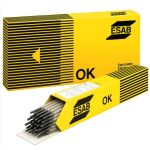Arc Welding Rods
Welding rods, often also called welding electrodes, are an essential consumable for stick welding and arc welding, a welding process that requires no shielding gas to weld metal. The welding rod creates the arc which generates the heat required to melt metals and bond them together. Arc welding rods come in different sizes and with different properties, with each type designed specifically for welding specific materials in different applications to ensure you get a clean joint when welding.
High tensile strength
Welding electrodes are often classified based on tensile strength and welding position, helping welders find the right rods for their welding task. You should also select the right welding rods for the materials you are welding and the equipment you have in order to always obtain a strong, consistent weld. Selection of the right welding electrode is essential when it comes to the strength of the weld, bead quality, minimal spatter and maintaining a stable arc. Welding rods are designed to withstand the intense heat generated by the electric arc, allowing them to melt and fuse with the base metals to form a strong joint bond.
There are also non-consumable electrodes which are used in TIG welding processes. These tungsten electrodes do not melt during the welding process and you can view our selection of tungsten electrodes elsewhere on site.
Welding Electrodes at Engweld
Engweld offers a wide range of welding rods including mild steel (rutile), low hydrogen (basic), stainless steel, repair and maintenance and cellulosic in a variety of sizes from 1.6 - 5.0mm for a broad range of welding applications, including the perfect electrodes for welding steel. We work with the biggest brands in the industry, including Bohler, ESAB, Lincoln Electric, and Oerlikon, to bring you the best welding rods. When selecting welding electrodes, you may either need them by packet or vacpac so be sure to check how many pieces these contain or also by the carton, which typically contain 3 or 6 packs depending on your needs and which volume would be most suitable.
Making the right selection
Selection of the right welding electrode is essential when it comes to the strength of the weld, bead quality, minimising splatter and clean-up. To achieve optimal penetration and a clean weld, welders must carefully adjust the rod current; too much rod current can lead to burn-through, while too little can result in inadequate fusion. The flux coating and chemical composition on the surface of a rod plays a crucial role in shielding the molten metal from atmospheric contaminants and improving the weld's overall quality. Welders often examine the surface of a rod for any signs of damage or moisture, as these can negatively impact the quality of the weld; even subtle imperfections on the surface can lead to issues like porosity or cracking. Read our guide below which explains what all the different types of rods are and what you metals you might use them for, including low hydrogen and stainless steel welding rods, plus arc welding rods suitable for welding mild steel, dissimilar steels and cast iron.
If you’re looking for an easy-to-strike, smooth-running rod suitable for mild steel fabrication, our 6013 electrodes are a popular choice for beginners and professionals alike.
Engweld also stocks welding electrode quivers and ovens for storing and warming electrodes for welding to achieve optimum performance.
If you need more information or need help choosing the right welding electrode for your application, please get in touch and speak to one of our experts.
Welding Rods Technical Comparison
This comparison focuses on the key technical elements of the listed ESAB and Oerlikon stick welding electrodes. The crucial difference is between the Rutile (E6013) and Basic (E7018) coating types, which dictates mechanical strength, hydrogen content, and application suitability.
| Electrode Type |
AWS A5.1 Classification |
EN ISO 2560-A Classification |
Coating Type |
Min. Tensile Strength (Approx.) |
Hydrogen Content (Typical) |
Main Application / Key Feature |
| ESAB OK 46.00 (Miltrode) |
E6013 |
E 38 0 RC 11 |
Rutile-Cellulosic |
60,000 psi (420 MPa) |
High |
Best All-Round Rutile. Excellent strike/re-strike, tolerance for impurities (rust/mill scale), good for short/tack welds. |
| ESAB OK 46.30 |
E6013 |
E 38 0 RC 11 |
Rutile-Cellulosic |
60,000 psi (420 MPa) |
High |
High Arc Stability. Very smooth arc, minimal spatter, excellent self-releasing slag. Easy to use in all positions (except vertical down). |
| Oerlikon Fincord M |
E6013 |
E 38 0 R 12 |
Rutile-Medium |
60,000 psi (420 MPa) |
High |
Exceptional Operability. Known as the "farmer's rod" for ease of use, smooth metal transfer, and good overhead/horizontal-vertical performance. |
| ESAB OK GoldRox |
E6013 |
E 42 0 RC 11 |
Rutile-Cellulosic |
60,000 psi (420 MPa) |
High |
Aesthetic Finish. Premium rutile for the cleanest, smoothest bead appearance and easiest self-releasing slag. (Aesthetics over strength). |
| ESAB OK 48.60 |
E7018 |
E 42 4 B 42 H5 |
Basic (Low Hydrogen) |
70,000 psi (480 MPa) |
Very Low (H5≤5ml/100g) |
Critical Welds. Required for heavy plate, pressure vessels, high-strength steel, and low-temperature applications. Requires moisture control (rod oven). |
Categories related to Welding Rods:



































